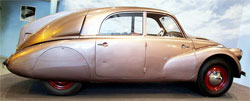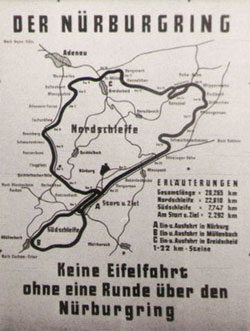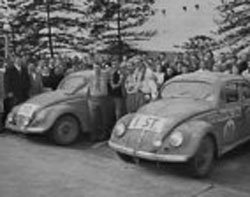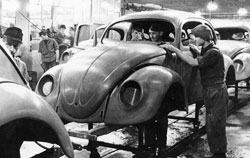|
In 1933, Adolf Hitler gave the order to Ferdinand Porsche to develop a "Volks-Wagen" . The concept may have been influenced by an earlier design of the same name, created by Josef Ganz, a Jewish engineer who had designed a "Volks-Wagen" in the 1920s
|
|
Hitler required a basic vehicle capable of transporting two adults and three children at 100 km/h (62 mph). The "People's Car" would be available to citizens of the Third Reich through a savings scheme at 990 Reichsmark, about the price of a small motorcycle (an average income being around 32RM a week). |
 |
Much of the Beetle’s design was inspired by the advanced Czech Tatra cars, designed under chief engineer Hans Ledwinka. In particular, Tatra’s T97 and T77a models show striking similarities with the later Volkswagen from many angles.
|
|
According to the book Car Wars, By Graeme Davison, Adolf Hitler called the Tatra 'the kind of car I want for my highways'. In the same book, it is said that Ferdinand Porsche admitted ‘to have looked over Ledwinka’s shoulder’ while designing the Volkswagen |
|
Tatra launched a lawsuit, but this was stopped when Germany invaded Czechoslovakia. At the same time, Tatra was forced to stop producing the T97. The matter was re-opened after WW2 and in 1961 Volkswagen paid Tatra 3,000,000 Deutsche Marks in compensation
|
|
The Ford company was offered the entire VW works after the war for free. Ford's right-hand man Ernest Breech was asked what he thought, and told Henry II, "What we're being offered here, Mr. Ford, isn't worth a damn!" With that, the Ford Motor Company lost out on the chance to build the world's most popular car since his grandfather's own Model-T
|
|
The Volkswagen factory at Wolfsburg was handed over by the Americans to British control in 1945; it was to be dismantled and shipped to Britain. Thankfully for Volkswagen, no British car manufacturer was interested in the factory; "the vehicle does not meet the fundamental technical requirement of a motor-car ... it is quite unattractive to the average buyer ... To build the car commercially would be a completely uneconomic enterprise."
|
|
The re-opening of the factory is largely accredited to British Army officer Major Ivan Hirst (1916–2000) - REME Corps. Hirst was ordered to take control of the heavily bombed factory, which the Americans had captured. His first task was to remove an unexploded bomb which had fallen through the roof and lodged itself between some pieces of irreplaceable production equipment; if the bomb had exploded, the Beetle's fate would have been sealed. Hirst persuaded the British military to order 20,000 of the cars, and by 1946 the factory was producing 1,000 cars a month
|
 |
In 1951, Volkswagen prototyped a 1.3 litre diesel engine. Volkswagen made only 2 air-cooled boxer diesel engines that were not turbocharged, and installed one engine in a Type 1 and another in a Type 2. The diesel Beetle was time tested on the Nürburgring and achieved 0-100 km/h (0-60 mph) in 60 seconds
|
| |
The first Volkswagen Beetle in the UK was sold in June 1953, in Sheffield, by Jack Gilder. He had been fascinated by both the design and engineering of the Beetle when he came across one in Belgium during the war. He applied for the franchise as soon as the opportunity presented itself and became Volkswagen’s representative in the North of England.
|
|
Following the Army-led restart of production,former Opel manager Heinz Nordhoff was appointed director of the Volkswagen factory, under whom production increased dramatically over the following decade, with the one-millionth car coming off the assembly line by 1955 |
|
In 1956, 22 Volkswagens were entered in the Australian Mobilgas Trial, a 13,600 km grulling rally around Australia.1956. Eddie Perkins’ VW finishes first and Bob Foreman’s VW is third, with other VWs in 4th, 6th, 9th and 10th |
 |
The 1957 Ampol Trial held in Australia was won by Jack Whitter in a VW. Other VW's in the demanding 11,200km rally came in 2nd and 7th. Of the 52 surviving cars to cross the finish line, 20 were Volkswagens.
|
 |
By 1959, demand for Volkswagens was so high that a new VW rolled off the final assembly lines every 19 seconds. |
|
During the 1960s and early 1970s, advertising campaigns and a reputation for reliability and sturdiness helped production figures to surpass the levels of the previous record holder, the Ford Model T. Beetle No. 15,007,034 broke the record on 17 February 1972. By 1973, total production was over 16 million, and by 23 June 1992, over 21 million had been produced.
|
| |
In 1962, more VWs were registered in the US than Studebakers, Lincolns, Renaults, Volvos, Mercedes, Triumphs, M.G.'s, and Porsches combined |
| |
In two daily shifts, the 46,000 workers at the Wolfsburg plant produced 4,700 cars a day in 1965. |
|
Owner-built Kitplanes, notably the Volksplane, are specifically designed to use these engines
|
|
Until 2001, Beetle engines were also used to run several of the ski lifts at the Thredbo Ski Resort in the Snowy Mountains, New South Wales Australia.
|
|
A Beetle engine drives the rotating Mercedes-Benz emblem on the top of the Europa-Center in Berlin On top of the high-rise, and visible across Berlin, is a large metal star-in-a-circle symbol, the logo of car manufacturer Mercedes-Benz. It weighs 15,000kg, has an outer diameter of 10 metres, completes approximately two revolutions a minute, and glows at night with the help of 68 fluorescent tubes. It can be tilted back for maintenance work, and in stormy weather it automatically turns into the wind.
|
|
The Zamboni HD ice resurfacer is powered by an LPG-powered Beetle engine
|
| |
The Amazonas, a Brazilian-built motorcycle manufactured from 1978 to 1990, uses a modified 1,600 cubic centimetres (98 cu in) Beetle engine and gearbox. With a dry weight that could top 350 kilograms (772 lb), the Amazonas was billed as the world's heaviest production motorcycle. The VW transmission's reverse gear, rare in a two-wheeled vehicle, was a useful feature in such a heavy motorcycle. There was later the Kahena with similar construction
|
| |
Many "trikes" have been built with Beetle engines
|
| |
In Europe, Beetle engines were used to power mobile water-pumps used by the fire brigade. These pumps have been used from the 1950s till the present day
|
| |
In 1967-68, the portable sawmill maker Mighty Mite of Portland, Oregon used VW engines to power the circular saw blades of light sawmills |

